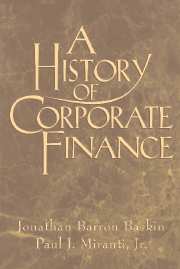Book contents
- Frontmatter
- Contents
- Preface
- Introduction: History and the Modern Theory of Finance
- Part I The Preindustrial World
- 1 Medieval and Renaissance Origins
- 2 Corporate Finance in the Age of Global Exploration: Trading Companies and Oceanic Discovery, 1450–1720
- 3 The Emergence of Public Markets for Investment Securities, 1688–1815
- Part II The Rise of Modern Industry
- Part III The Transition to the Contemporary Era
- Epilogue
- APPENDIX A Finance and Informational Asymmetries in the Ancient World
- APPENDIX B International Patterns of Corporate Governance
- Index
2 - Corporate Finance in the Age of Global Exploration: Trading Companies and Oceanic Discovery, 1450–1720
Published online by Cambridge University Press: 22 March 2010
- Frontmatter
- Contents
- Preface
- Introduction: History and the Modern Theory of Finance
- Part I The Preindustrial World
- 1 Medieval and Renaissance Origins
- 2 Corporate Finance in the Age of Global Exploration: Trading Companies and Oceanic Discovery, 1450–1720
- 3 The Emergence of Public Markets for Investment Securities, 1688–1815
- Part II The Rise of Modern Industry
- Part III The Transition to the Contemporary Era
- Epilogue
- APPENDIX A Finance and Informational Asymmetries in the Ancient World
- APPENDIX B International Patterns of Corporate Governance
- Index
Summary
Introduction
Although trade remained an important means for generating wealth, the primary channels of international commerce began to change radically in the fifteenth century because of oceanic discoveries. The advantages enjoyed by the Italian city-states as entrepots for the trade between Europe and the East first started to decline as explorers charted new sea routes around Africa. The process started with the Portuguese, who, encouraged by Prince Henry the Navigator, opened trade with the African Gold Coast in 1448. By 1488, Bartholomew Dias anchored at the Cape of Good Hope, which served as the base a decade later for the voyage of Vasco Da Gama to Calicut on the Indian Malibar Coast. The frontiers of trade were further broadened by trans-Atlantic exploratory expeditions. In 1492, the Genoese captain Christopher Columbus found America while searching for a Western route to Asia on behalf of Ferdinand and Isabella of Spain. In 1498, the Venetian Sebastian Cabot, in search of a North Atlantic route to the Indies, laid claim to Newfoundland for the English Crown. In 1500, the Portuguese Pedro Alvares Cabral led a voyage that first landed in Brazil and then continued to India. The zenith was reached in 1519–22 with the Spaniard Ferdinand Magellan's global circumnavigation.
The extended economic horizons opened by the increase in geographic knowledge created a favorable environment for the development of innovative organizations capable of conducting large-scale, long-distance trading activities. Foremost in this regard was the jointstock company, which, while appearing at many European commercial centers, reached maturity in England.
- Type
- Chapter
- Information
- A History of Corporate Finance , pp. 55 - 88Publisher: Cambridge University PressPrint publication year: 1997



